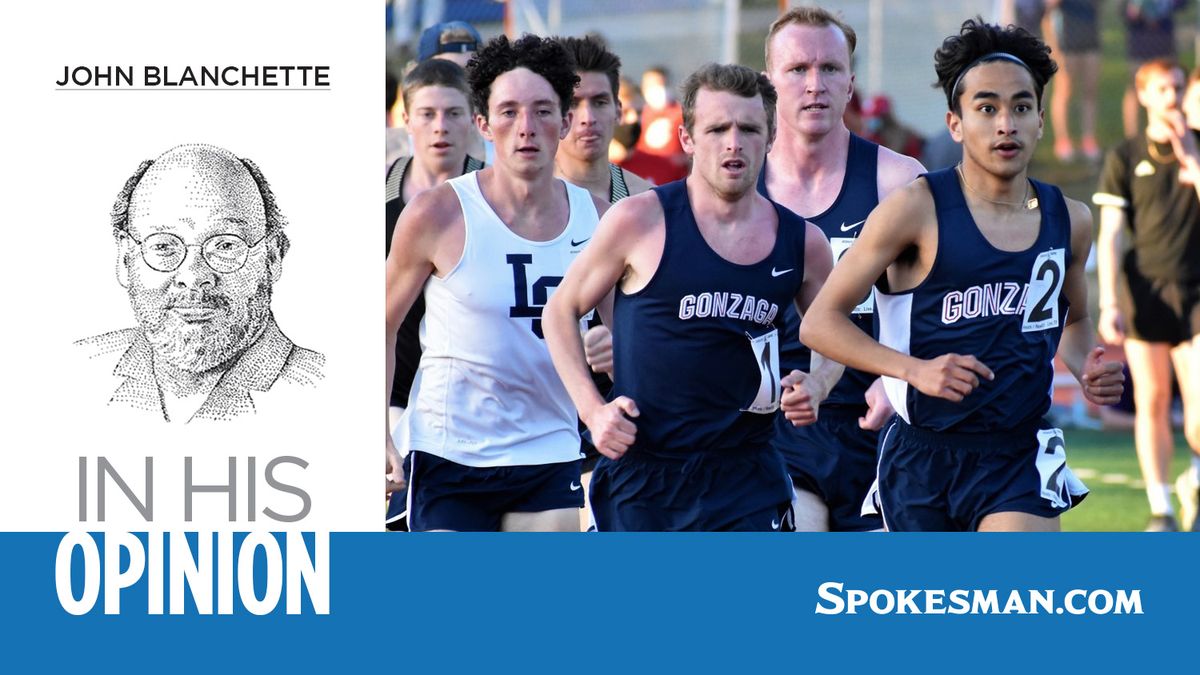John Blanchette: Gonzaga runners are going the distance

Pat Tyson turned 71 the other day, waking up to find that two more of his Gonzaga University runners had squeezed into the field for the preliminary round of qualifying for the NCAA track and field championships.
And we do mean squeezed.
Forty-eight get taken. Jake Perrin and Alex Walde were 48th on the list in the 5,000 meters and the steeplechase, respectively.
This makes the odds steep that they’ll be among the 12 survivors who advance to the big meet in Eugene next month, but never mind that.
The news had Tyson – GU’s men’s track head coach – still jazzed days later, even if it’s not something that will register on his resume.
As a collegian at Oregon, he ran on an NCAA championship cross country team with his roommate Steve Prefontaine, and as a coach at Mead High School he built a dynasty that won state titles.
Now he’s been coaxing the best out of distance runners for close to 50 years – and it’s all just part of the same high.
“People may not realize it, but Gonzaga is a very special place to be a distance runner,” said Yacine Guermali, one of the six Zags competing this weekend in Texas, “and Tyson is a big reason. We recognize how lucky we are to have that kind of mentor.”
It is Tyson’s reputation that obliges us to check in every so often on his Gonzaga project, now 13 years ongoing.
As ever, it’s complicated.
For at Gonzaga, every athletic program finds itself uneasily compared to basketball in the public reckoning – or not at all, given all the oxygen required to tend that flame. If we invoke the old blueblood standard the Zags of March inevitably confront, then no – the running Bulldogs are not bluebloods.
Consider that in west prelims in College Station, Stanford will have nine runners in the 5,000 meters alone. Brigham Young has 12 qualified in the three long races.
But also consider the Zags have more in the hunt than either Oregon or Colorado, and the running blood gets no bluer.
“I got a text the other day from John Dressel at Colorado,” Tyson reported, referencing the former Mt. Spokane runner who’s having a standout senior year himself. “He said, ‘You’ve got two guys under 29 minutes (for 10,000 meters)? I hope they punch their ticket to Eugene.’ He was surprised – and excited for us.
“I think we’re one of the top 20 distance running programs in the country.”
This at a school with no track of its own, no lure of being a high-altitude mecca and roughly three scholarships to divvy up.
But no complaints, either.
Even during a year when everyone everywhere had a complaint.
COVID-19 wiped out the 2020 track season and pushed fall cross country into spring, and it did its best to knock out the Zags, too. The program had shutdowns in October and January – the second time because Tyson contracted the virus. They ran their abbreviated cross country schedule – beating Portland for the first time to take second in the West Coast Conference and finishing 27th in their first nationals appearance in March.
Then their top runner, James Mwaura tested positive so there was another shutdown; he estimated up to 17 GU runners were affected.
Yet a month later, he took 10 seconds off the 5,000 record he set as a freshman in 2019. Two weeks ago, he took the 10,000 standard down to 28:27.49.
“I think without COVID, I could have run 13:20 (in the 5,000) by now,” he said. “Other guys were set back, too. Yacine was in great shape and he got hit hard.”
Nevertheless, Guermali broke the GU the school record for 1,500 meters last week with a 3:43.59 – about a 4:01 mile.
But this is something of a national trend. Tyson noted distance times this spring have been “insane.” Peter Hogan, GU’s other sub-29 10K runner, assessed it as a “perfect storm.” Elite-level runners shooting for Olympic qualifiers have accounted for some fast pacing in invitational races. With jobs and internships on hold last summer, runners were able to invest themselves in training – a number of Zags headed to Flagstaff, Arizona, for two months of altitude work. And school, Hogan said, has become “more flexible – you’re not seeing the all-nighters.
“There was a whole year of training without having to worry about racing, and people have used it to get faster.”
So the road to Eugene will be swift, and only Mwaura in the 10,000 has a top 12 time going in. But whatever the results, Tyson never fails to appreciate the stories that make up a team.
Hogan grew up in baseball great Ron Santo’s house in Seattle (“Tyson gets way more excited about that than I do,” he said).
Guermali is the son of a former Moroccan distance man who now represents top international runners. Mwaura, who came with his family to Tacoma from Kenya at age 7, was a state champion and a “legit top five recruit,” Tyson said – meaning he got one before even Mark Few did. And steeplers Ben Hogan and Walde, who’s from Coeur d’Alene, are typical walk-on successes. Coming up are talents like freshman Wil Smith of Lewis and Clark, who was 11th in his first collegiate cross country race at the WCCs.
“That’s why I don’t retire,” said Tyson, one year older. “There’s fruit on the tree, and you’ve got to eat it.”